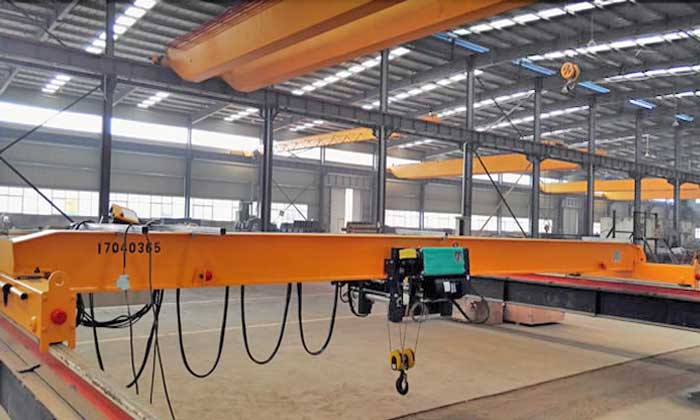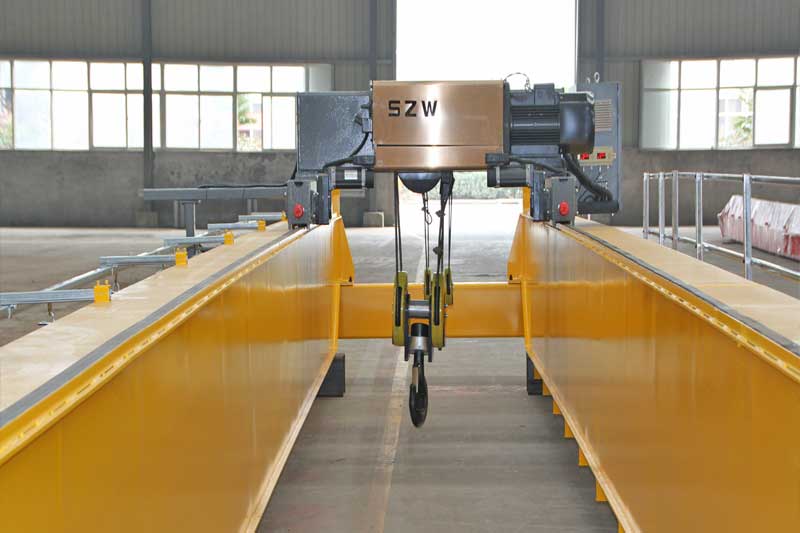How Overhead Cranes Enhance Cashmere Fabric Production in Mongolia
Overhead crane for sale Mongolia. Custom overhead bridge crane 2 ton, 3 ton, 5 ton, 10 ton, up to 80 ton for sale Mongolia. Get your custom overhead crane!
How Overhead Cranes Enhance Cashmere Fabric Production in Mongolia
Cashmere fabric production stands as a hallmark of excellence in the textile industry, renowned for its unparalleled softness, warmth, and luxurious appeal. At the heart of this intricate process lie spinning and weaving operations, where cashmere fibers are transformed into exquisite fabric, cherished by discerning consumers worldwide. In this document, we delve into the pivotal role that spinning and weaving play in cashmere fabric production, and how overhead cranes serve as indispensable tools in streamlining these operations.
Cashmere fabric holds a distinguished place in the textile landscape, revered for its exceptional quality and unparalleled comfort. Originating from the fine undercoat of cashmere goats, these fibers undergo a meticulous journey of processing to emerge as the coveted fabric known for its softness, warmth, and luxurious feel. From high-end fashion garments to cozy accessories, cashmere fabric adorns the shelves of boutiques and wardrobes of fashion enthusiasts, epitomizing elegance and sophistication.
Spinning and weaving operations stand as the cornerstone of cashmere fabric production, where raw fibers are spun into yarn and woven into fabric. In the spinning process, the delicate cashmere fibers are transformed into fine yarn, ready to be woven into fabric. Weaving, on the other hand, involves the intricate interlacing of yarn to create fabric panels of various textures and patterns. These operations demand precision, expertise, and efficient material handling to ensure the seamless flow of production and the preservation of cashmere's inherent qualities.
Single girder overhead crane 1 ton to 20 ton for sale Mongolia
Spinning Operations
The spinning process is a pivotal stage in cashmere fabric production, where raw cashmere fibers undergo transformation into fine yarn. This process begins with the cleaning and dehairing of the raw cashmere fibers to remove impurities and separate the desirable undercoat fibers from the coarse guard hairs. Once cleaned, the cashmere fibers are carded and combed to align the fibers and create a consistent fiber web. Subsequently, the aligned fibers are drawn and twisted into yarn through spinning machines, producing the delicate strands of cashmere yarn ready for weaving into fabric. The spinning process is crucial as it determines the quality, strength, and consistency of the yarn, laying the foundation for the final fabric's characteristics.
Challenges and Complexities in Spinning Cashmere Fibers
Spinning cashmere fibers presents unique challenges and complexities due to the delicate nature of the fibers and their fine diameter. Cashmere fibers are exceptionally soft and lightweight, making them prone to tangling, breakage, and fiber entanglement during the spinning process. Achieving uniformity in yarn thickness and strength poses challenges, requiring precise control over tension, twist, and drafting to ensure consistent yarn quality. Moreover, variations in fiber length, fineness, and fiber alignment further add to the complexities of spinning cashmere fibers, necessitating careful monitoring and adjustment of spinning parameters to maintain yarn integrity and quality.
Introduction to the Role of Overhead Cranes in Facilitating Spinning Operations
Overhead cranes play a crucial role in facilitating spinning operations by providing efficient material handling solutions and supporting the seamless flow of production. These cranes are utilized to transport raw cashmere bales, spinning machinery, and intermediate products between different stages of the spinning process, ensuring continuous workflow and minimizing downtime. By lifting and positioning heavy equipment and materials with precision and control, overhead cranes enable operators to optimize machine setup, maintenance, and changeovers, thereby enhancing overall productivity and efficiency in spinning operations. Additionally, overhead cranes contribute to a safer working environment by reducing manual handling tasks and minimizing the risk of accidents or injuries associated with heavy lifting. In the next section, we will explore the specific challenges and complexities faced in weaving cashmere fibers into fabric and the role of overhead cranes in overcoming these obstacles.
Weaving Operations
The weaving process is a vital stage in the transformation of cashmere yarn into fabric, where intricately interlaced yarns form the basis of the final textile. Weaving involves the systematic arrangement of yarns on a loom, with each yarn traversing over and under others to create a cohesive fabric structure. Cashmere yarns, known for their fine texture and softness, lend themselves beautifully to weaving, resulting in luxurious fabrics coveted for their warmth and comfort. The weaving process plays a crucial role in determining the fabric's texture, pattern, and drape, making it a key aspect of cashmere fabric production.
The Intricacies of Weaving Cashmere Fabric
Weaving cashmere fabric entails a series of intricate steps and precise adjustments to achieve the desired fabric characteristics. Cashmere yarns, being fine and delicate, require careful handling to prevent breakage and ensure uniformity in the woven fabric. Weavers must meticulously set up the loom, adjusting warp tension, and yarn spacing to accommodate the specific properties of cashmere yarns. Additionally, the choice of weave structure—whether plain, twill, or satin—impacts the fabric's appearance and performance, requiring thoughtful consideration in the design process. The weaving of cashmere fabric demands skill, patience, and attention to detail to produce textiles of exceptional quality and craftsmanship.
Overhead Cranes Enhance Weaving Operations
Overhead cranes play a vital role in enhancing weaving operations by providing efficient material handling solutions and supporting the seamless execution of production tasks. These cranes are instrumental in transporting raw materials, equipment, and finished products between different stages of the weaving process, ensuring uninterrupted workflow and minimizing downtime. By lifting and positioning heavy machinery, yarn spools, and fabric rolls with precision and ease, overhead cranes enable weavers to optimize production efficiency and maintain consistent fabric quality. Furthermore, overhead cranes contribute to a safer working environment by reducing manual handling tasks and minimizing the risk of accidents or injuries associated with heavy lifting. Their versatility and adaptability make them invaluable assets in modern weaving facilities, where efficiency and safety are paramount. In the next section, we will delve into the specific benefits and advantages of overhead cranes in enhancing weaving operations within cashmere fabric production.
Double girder overhead crane 3 ton to 80 ton for sale
Benefits of Overhead Cranes in Spinning and Weaving
Increased Efficiency and Productivity through Optimized Material Handling
Overhead cranes play a crucial role in enhancing efficiency and productivity in spinning and weaving operations by optimizing material handling processes. These cranes are adept at lifting and transporting heavy machinery, raw materials, and finished products with precision and speed, minimizing downtime and streamlining workflow. By automating material movement tasks that would otherwise require manual labor, overhead cranes enable operators to focus on core production activities, leading to higher throughput and increased production output. The seamless integration of overhead cranes into spinning and weaving operations facilitates smooth material flow, ensuring continuous operation of machines and reducing idle time, thereby maximizing overall efficiency and productivity.
Enhanced Safety for Workers and Delicate Materials during Lifting and Transporting
Safety is paramount in spinning and weaving operations, where workers are exposed to heavy machinery and delicate materials. Overhead cranes contribute to a safer working environment by minimizing manual handling tasks and reducing the risk of accidents or injuries associated with lifting and transporting heavy loads. These cranes are equipped with advanced safety features such as overload protection, emergency stop buttons, and collision avoidance systems, ensuring the safe and controlled movement of materials throughout the production process. By eliminating the need for workers to manually lift and carry heavy loads, overhead cranes protect workers from ergonomic strains and musculoskeletal injuries, promoting a healthier and safer workplace environment.
Improved Workflow Integration and Coordination between Spinning and Weaving Processes
The seamless integration of spinning and weaving processes is essential for maintaining a continuous and efficient production flow in cashmere fabric production. Overhead cranes play a pivotal role in facilitating workflow integration by providing flexible and agile material handling solutions that support the seamless transition of materials between different production stages. These cranes enable operators to transport raw materials, intermediate products, and finished goods between spinning and weaving departments with ease, ensuring timely delivery of materials to the next processing stage. By optimizing workflow coordination and minimizing bottlenecks, overhead cranes contribute to the overall efficiency and effectiveness of spinning and weaving operations, ultimately enhancing the competitiveness and profitability of cashmere fabric production facilities.
Specific Applications of Overhead Cranes
Explanation of How Overhead Cranes are Used to Transport Raw Materials, Equipment, and Finished Products
Overhead cranes serve as versatile and reliable tools for transporting various materials, equipment, and finished products within spinning and weaving operations. These cranes are utilized to lift and move raw cashmere bales, spinning machinery, yarn spools, and fabric rolls between different workstations and production stages. In the spinning process, overhead cranes are employed to transport raw cashmere bales from storage areas to processing stations, facilitating the loading of fiber into cleaning and carding machines. During the weaving process, overhead cranes are utilized to move yarn spools and fabric rolls between looms, winding machines, and finishing stations. Additionally, overhead cranes play a crucial role in handling finished products, lifting fabric rolls from looms and transporting them to inspection, packaging, and storage areas. By providing efficient and reliable material handling solutions, overhead cranes contribute to the seamless flow of production, minimizing handling time, and ensuring timely delivery of materials to the next processing stage.
Discussion on the Versatility and Adaptability of Overhead Cranes in Different Spinning and Weaving Setups
One of the key advantages of overhead cranes is their versatility and adaptability to different spinning and weaving setups. These cranes come in various configurations, including single girder, double girder, and gantry cranes, allowing them to accommodate different production layouts and space constraints. Overhead cranes can be customized with features such as telescopic booms, extended reach, and specialized lifting attachments to meet the specific requirements of cashmere fabric production facilities. They can be installed above production lines, weaving looms, and storage areas, providing flexible material handling solutions tailored to the unique needs of each operation. Whether handling delicate cashmere fibers or heavy machinery, overhead cranes offer precise control, smooth movement, and reliable performance in diverse spinning and weaving setups, ensuring optimal productivity and efficiency.
Solutions Tailored to the Needs of Cashmere Fabric Production
Innovative crane solutions tailored to the needs of cashmere fabric production include specialized lifting attachments, automation features, and advanced safety systems. For example, vacuum lifters and clamps are commonly used to handle delicate cashmere fibers and fabric rolls without causing damage or distortion. Automated overhead cranes equipped with sensors and programmable controls enable seamless material handling and precise positioning, reducing human error and increasing productivity. Safety features such as anti-sway systems, proximity sensors, and overload protection mechanisms enhance the safety of crane operations, minimizing the risk of accidents and injuries in cashmere processing plants. These innovative crane solutions are designed to optimize material handling efficiency, maximize production throughput, and ensure the quality and integrity of cashmere fabric throughout the manufacturing process.
Conclusion: Custom Overhead Crane for Your Needs
Throughout this document, we have explored the pivotal role that overhead cranes play in streamlining spinning and weaving operations within cashmere fabric production. We discussed how overhead cranes optimize material handling processes, enhance safety measures, and improve workflow integration in spinning and weaving setups. From transporting raw materials to handling finished products, overhead cranes serve as indispensable tools for ensuring the smooth and efficient operation of cashmere processing plants.
The utilization of overhead cranes has a profound impact on the productivity, efficiency, and quality of cashmere fabric production. By providing efficient material handling solutions, overhead cranes minimize downtime, reduce manual labor, and optimize workflow coordination, leading to increased production throughput and improved resource utilization. Furthermore, overhead cranes enhance safety measures, protecting workers and delicate materials from accidents and injuries. The consistent and precise handling of materials by overhead cranes ensures the integrity and quality of cashmere fabric, meeting the high standards expected by consumers and stakeholders.




